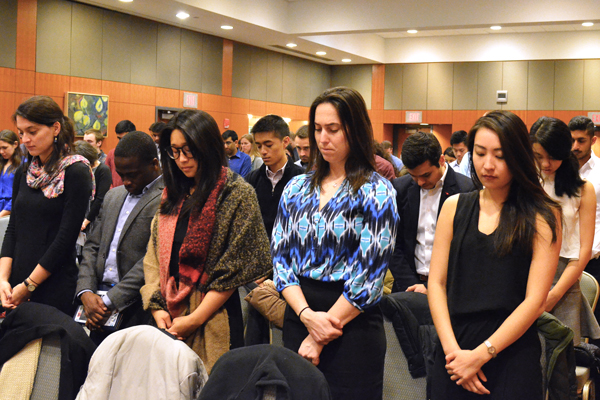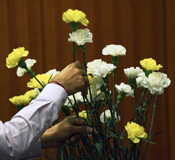
Dissecting a human body is part of the foundational education—and a rite of passage—for first-year Harvard medical and dental school students. Last fall, working in groups of four, students in the Pathways and Harvard-MIT Health Sciences and Technology curriculums spent 60-plus hours in the anatomy lab with the bodies of 27 women and 25 men.
To gain the objectivity needed to learn the intricacies of the major organ systems of the human body, the students must develop what is called “detached concern,” which is partly what the anatomy class is all about.
“It’s a crucial skill in working optimally with living patients… and navigating the emotional difficulties of performing clinical procedures on patients, living or dead,” said Trudy Van Houten, co-director of the first-year Foundations anatomy course.
The donors to the Anatomical Gift Program at Harvard Medical School entrusted their bodies to the students so that the students can learn and countless future patients can benefit from the knowledge the students gain. The students, in their own turn, took steps to recognize the selfless generosity of the donors.
“The donors really invested in our education without knowing us at all, and I think that it is so, so special. It’s something to be grateful for,” said Megan Jang ’19, a student organizer for the Anatomical Donor Memorial Ceremony, which was held on March 1 in the Pechet room in the New Research Building.
The ceremony, sponsored each year by the HMS Anatomical Gift Program, was near capacity, with approximately 100 students and faculty members paying tribute to the dozens of people who offered their remains for education and research.
For the students, it was a way to connect with the donors—paying tribute to and honoring them as the humans they once were—full of life and love. The program included musical performances, readings and personal reflections.
Flutist Clara Yang ’19 played Claude Debussy’s “Syrinx” and noted how the piece expressed the emotions she had experienced in the anatomy lab: “surprise, joy, hesitation, sadness and death.”
Because of donor confidentiality, the students are never given specific information about the individuals on whose bodies they work all semester.
“I wondered what these hands had done. The people they had touched. The rings they had worn,” said student Jessica Stuart ’19 during the ceremony, reading aloud a short piece she had written.
“I felt the urge to hold them. To thank her. But I didn’t,” she said.
Martha Katz, an HMS anatomy instructor and instructor in medicine at Brigham and Women’s Hospital, described detached concern as one way of being able to hold multiple and often contradictory thoughts at the same time—the students had times of focus when they were concentrating on acquiring skills interspersed with moments of emotion and introspection.
During anatomy class, the students were also supported by their peers and coached by their instructors as they struggled with new and unfamiliar emotions.

At the memorial ceremony they finally had the opportunity to discover more about the donors as they recited a list of their occupations—an artist, two engineers, an innkeeper, a custodian, four teachers, a waitress, a lawyer, seven homemakers, a registered nurse and many others with careers across a range of fields.
Afterward, the donors’ first names were read aloud while the students came forward, one by one, and placed a flower for each in a vase at the front of the room.
After a moment of silence, students and faculty were then invited to share their personal reflections and experiences—from struggling with the gravity and sadness inherent in some of the lessons to their thoughts on mortality to the beauty and power of something as simple as human touch.
Several said they wished they could have told the donors’ families how much they thought about them.
Many expressed gratitude for being given an extraordinary opportunity to learn.
“Every single body was a person,” said Jang. “And that’s really what the donor ceremony is about.”


